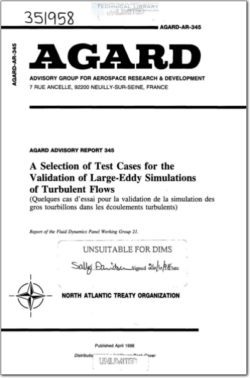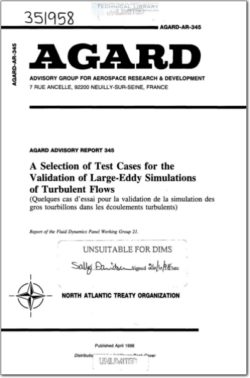AGARD-AR-345

- Version
- 232 Downloads
- 9.04 MB File Size
- 1 File Count
- April 25, 2016 Create Date
- April 25, 2016 Last Updated
A Selection of Test Cases for the Validation of Large-Eddy Simulations of Turbulent Flows

Our ability to optimize the performance of civil and military aircraft is limited by the current
understanding of complex turbulent processes. Progress in turbulence modeling and simulation has
been hampered by the lack of well documented, systematically verified, experimental and numerical
data bases of relatively simple building block flows for the validation of computational methods.
The two basic ways of computing turbulence have traditionally been direct numerical simulation (DNS)
and Reynolds—averaged (RANS) modelling. In the former, the full, time—dependent, Navier-Stokes
equations are solved numerically, essentially without approximations. The results are equivalent to
experimental ones. In the latter, only the stationary mean flow is computed, and the effect of the
unsteady turbulent velocity fluctuations is modelled according to a variety of physical approximations.
It was realized early that direct numerical simulations were too expensive for most cases of industrial
interest, while Reynolds-averaged modelling was too dependent on the characteristics of particular
flows to be used as a method of general applicability.
Large-eddy simulations (LES) were developed as an intermediate approximation between these two
approaches, the general idea being that the large, non-universal, scales of the flow were to be computed ,
explicitly, as in DNS, while the small scales were modelled. The hope was that the small scales, which
are removed from the flow inhomogeneities and particular bOundary conditions by several steps of the
turbulent cascade, would be universal (independent of the particular flow) and isotropic enough for a
single simple model to be able to represent them in all situations.
The data contained in the present collection are intended for the validation of large-eddy simulations of
turbulent flows, especially at the fundamental level of model development rather than at the level of
complete codes. They therefore include relatively few ‘complex’ flows, consisting instead of ‘building-
block’ experiments documented in as much detail as possible. These should also be useful for the
validation of RANS and for the preliminary evaluation of experiments or turbulence theories. They
include both laboratory experiments and direct numerical simulations.
| File | Action |
|---|---|
| AGARD-AR-345 A Selection of Test Cases for the Validation of Large-Eddy Simulations of Turbulent Flows.pdf | Download |
Comment On This Post